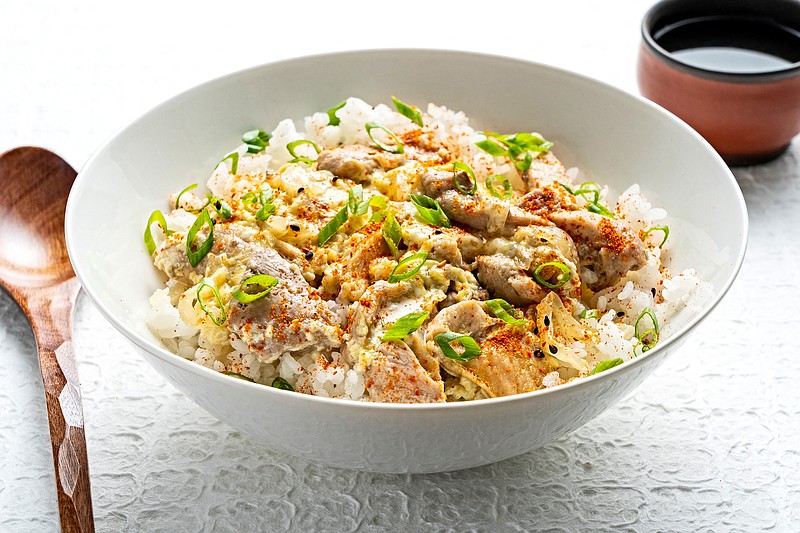If any dish were a poem, oyakodon would come pretty darned close. Preparation begins by slowly warming up dashi and sending sliced onions for a tumble into a savory broth. Eggs are lightly beaten and poured gingerly over chicken thighs and mellowed-out onions. You can't rush oyakodon — patience rewards the cook with pillowy eggs, juicy chicken and a fistful of onions soft to the bite. All the while, the sweet aroma of dashi envelops the kitchen like a cozy, weighted blanket.
And then there's the name itself: Oyakodon, a Japanese chicken and egg rice bowl, translates literally to "parent-and-child donburi." The dish is a nod to the perplexing, perennially debated chicken-egg dilemma. (Which came first: The chicken or the egg, the dish seems to jest.) Taking inspiration from a similar Chinese chicken and egg dish, Paul Simon, in his song "Mother and Child Reunion," sings of a poetic reunion: "No, I would not give you false hope / On this strange and mournful day / But the mother and child reunion / Is only a motion away."
Like a poetic song, making oyakodon evokes intense family memories around the dinner table as well as the time I learned to live alone.
Those five months in early 2021 were some of the loneliest. At first, I welcomed the quiet, explorative change. With a kitchen all to myself, I indulged in elaborate dishes and fanciful cakes but found myself stumped and slumped when I couldn't share them with anyone. It was only when I embraced the simple, unfussy art of one-pot dishes that I found myself gravitating back to the kitchen. Skillet in hand, I sampled my way through Japanese and Vietnamese comfort foods and insisted on learning traditional Chinese dishes from my grandmother on WeChat.
Soon enough, oyakodon wriggled its way into my weekly dinner rotation. A comforting spoonful of egg, chicken and rice served as a reminder that food could heal even the loneliest of pangs. To this day, when asked to whip up my favorite recipe from when I lived alone, I pull out my skillet and declare it oyakodon time.
As with a favorite poem, there are many ways to interpret this dish. If you prefer more onions, cut more onions. Feeling a dash of spice or slightly bitter bite? Consider adding shichimi togarashi, a Japanese seasoning blend, or mitsuba, a Japanese herb similar to parsley. And for an equally delicious vegetarian spin, tofu will soak up all that savory broth. Oyakodon lends itself well to culinary riffs, and soon it can become an indispensable part of your weekly dinner rotation, just as it had for me.
Dashi, mitsuba and shichimi tograshi are available at Asian and speciality grocers and online.
Oyakodon (Japanese Chicken and Egg Rice Bowl)
- 1 cup instant or homemade dashi
- 2 teaspoons mirin OR sake
- 2 teaspoons soy sauce
- 1 teaspoon granulated sugar
- ½ medium yellow onion (4 ounces total), thinly sliced
- 3 boneless skin-on or skinless chicken thighs, sliced (see notes)
- 3 large eggs, beaten lightly
- Chopped green onions, for garnish (optional)
- Mitsuba, for garnish (optional)
- 2 cups cooked Japanese-style short-grain white rice, for serving
- Shichimi togarashi, for serving (optional)
In a medium skillet over medium heat, combine the dashi, mirin, soy sauce and sugar and bring to a simmer. Taste and season with more soy sauce and/or sugar, if desired. Add the onions and simmer until they begin to soften, 6 to 7 minutes.
Arrange the chicken around the skillet and simmer until it is opaque and white on the outside, 6 to 7 minutes total.
Pour the beaten eggs in a smooth stream over the skillet until the egg mixture covers all of the surface area. The texture of the eggs will look soupy, but that's normal. Cover the pan and let the eggs fully cook, 2 to 3 minutes, or until the eggs become custardy. Uncover, sprinkle the green onions and/or mitsuba, if using, over the eggs, and remove from the heat.
To serve, divide the rice among the bowls, followed by the oyakodon. Serve with the shichimi togarashi at the table for heat.
Makes 2 to 3 servings.
Notes: Chicken breast, cut into 1 to 1 ½ inch pieces, and sliced tofu take less time to cook, 3 to 4 minutes total.
For crispier chicken, brown the chicken on both sides before adding the other ingredients. Then, transfer it to a plate. Proceed with the recipe, arranging the cooked chicken evenly around the skillet before adding the eggs.
